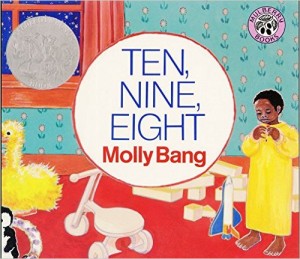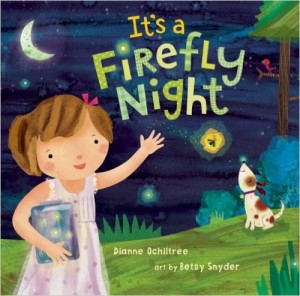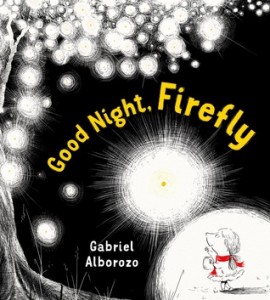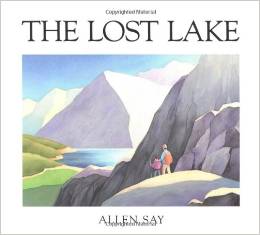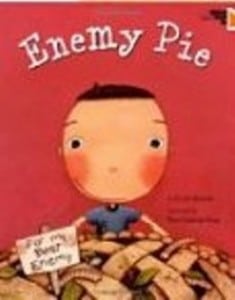On the heels of Mother’s Day we review books that expand our understanding of what it means to be part of a family and that validate the spectrum of family constellations in our children’s world.
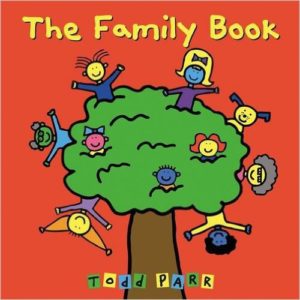 The Family Book written and illustrated by Todd Parr with his signature bold style and brevity, captures the variety and importance of family. His illustrations include diverse “races” (pink, blues, yellow, green, etc.), numbers, and configurations–including single parents as well as same-gender parents. The colorful illustrations catch the eye, hold the reader’s attention and affirm the idea that family is about love and connection.
The Family Book written and illustrated by Todd Parr with his signature bold style and brevity, captures the variety and importance of family. His illustrations include diverse “races” (pink, blues, yellow, green, etc.), numbers, and configurations–including single parents as well as same-gender parents. The colorful illustrations catch the eye, hold the reader’s attention and affirm the idea that family is about love and connection.
 AQ Lens: For adopted children this book can offer a way of discussing differences like race and/or family composition in an abstract way: pink, green and blue people which offers an insulating layer that may make it feel less “personal” and those “safer” to explore. #AAQ
AQ Lens: For adopted children this book can offer a way of discussing differences like race and/or family composition in an abstract way: pink, green and blue people which offers an insulating layer that may make it feel less “personal” and those “safer” to explore. #AAQ
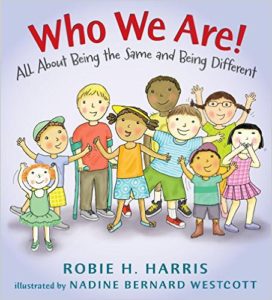 Who We Are by Robie H. Harris and illustrated by Nadine Bernard Westcott, is subtitled: All about Being the Same and Being Different, is straightforward in its efforts to validate diversity in individuals and in their families. It goes into greater detail than Parr’s The Family Book and is appropriate for a slightly older reader. Using the concept of visiting “Funland” as a logical place to encounter an array families, Who We Are focuses on the commonalities that we share and still affirms that each of us is unique.
Who We Are by Robie H. Harris and illustrated by Nadine Bernard Westcott, is subtitled: All about Being the Same and Being Different, is straightforward in its efforts to validate diversity in individuals and in their families. It goes into greater detail than Parr’s The Family Book and is appropriate for a slightly older reader. Using the concept of visiting “Funland” as a logical place to encounter an array families, Who We Are focuses on the commonalities that we share and still affirms that each of us is unique.
The illustrations are broadly inclusive in terms of ethnicity, race, ability, family constellation and body type and activity preferences. The text describes how sometimes differences can make us hesitate or be afraid of people who differ from us in some way. It explains how melanin influences eye, hair and skin color and then reassures readers by highlighting the commonalities of fundamental humanity that we share.
 AQ Lens: For adopted children this book can offer an easy opening to discussing race as well as the many ways in which children can be both different and similar to their adopted families–and/or their birth families if they have an open adoption or knowledge of their birth information. The tone of the book is both affirming and supportive. #AAQ [bctt tweet=”Kids can be both different & similar to both their families–adopted & birth.” username=”GayleHSwift”]
AQ Lens: For adopted children this book can offer an easy opening to discussing race as well as the many ways in which children can be both different and similar to their adopted families–and/or their birth families if they have an open adoption or knowledge of their birth information. The tone of the book is both affirming and supportive. #AAQ [bctt tweet=”Kids can be both different & similar to both their families–adopted & birth.” username=”GayleHSwift”]
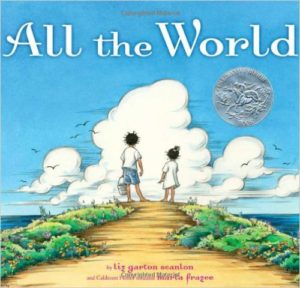 All the World is written by Liz Garton Scanlon and illustrated by Marla Frazee, strives to picture the universals that all people and families share: family love, the pleasure of play–and its variety, parental nurturing, etc. The book repeats the refrain: “All the world is …” then the detailed illustrations capture many ways in which each concept is embodied. The vignettes overflow with examples of variety; we see types of cars, boats, gardens, byways, weather, foods, etc. There’s truly something for everyone. The delicate rhymes conclude: Hope and peace and love and trust/ All the world is all of us.” Children will appreciate that the world surrounds us and is within ourselves as well.
All the World is written by Liz Garton Scanlon and illustrated by Marla Frazee, strives to picture the universals that all people and families share: family love, the pleasure of play–and its variety, parental nurturing, etc. The book repeats the refrain: “All the world is …” then the detailed illustrations capture many ways in which each concept is embodied. The vignettes overflow with examples of variety; we see types of cars, boats, gardens, byways, weather, foods, etc. There’s truly something for everyone. The delicate rhymes conclude: Hope and peace and love and trust/ All the world is all of us.” Children will appreciate that the world surrounds us and is within ourselves as well.
I predict that this moody book will be one which readers will select from their shelves again and again.
 AQ Lens: adopted children this book can offer a chance to see diversity in a larger swath because the double spread illustrations depict many ways of seeing or experiencing a concept. Instead of seeing difference in an isolated moment or single example, it is seen as part of a complex fabric that holds the varying elements of the spectrum simultaneously.#AAQ Lens
AQ Lens: adopted children this book can offer a chance to see diversity in a larger swath because the double spread illustrations depict many ways of seeing or experiencing a concept. Instead of seeing difference in an isolated moment or single example, it is seen as part of a complex fabric that holds the varying elements of the spectrum simultaneously.#AAQ Lens
Here Is the Baby 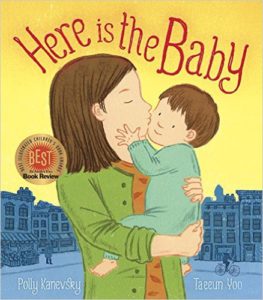 I predict that this moody book will be one which readers will select from their shelves again and again.by Polly Kanevsky follows a baby throughout his day. Readers travel with him from Mama retrieving him from his crib until she eases him down for his evening’s rest. During baby’s busy day, his parents and sibling, feed, care for and play with him. Clearly he is a well-loved and nurtured child.
I predict that this moody book will be one which readers will select from their shelves again and again.by Polly Kanevsky follows a baby throughout his day. Readers travel with him from Mama retrieving him from his crib until she eases him down for his evening’s rest. During baby’s busy day, his parents and sibling, feed, care for and play with him. Clearly he is a well-loved and nurtured child.
Daddy is the one who walks sister to school, strolls baby around the neighborhood and brings him to the library for story time and plays with him at the park. This is a welcome depiction of hands-on fathering!
Although the family is Caucasian, some limited diversity is represented in the characters who appear in the background.
 AQ Lens: For adopted children this book shows both parents as involved caretakers. though the story depicts a two-parent family, much of the story shows Dad doing the parenting. This may help it appeal to families that have only a father (or fathers). #AAQ Lens
AQ Lens: For adopted children this book shows both parents as involved caretakers. though the story depicts a two-parent family, much of the story shows Dad doing the parenting. This may help it appeal to families that have only a father (or fathers). #AAQ Lens




